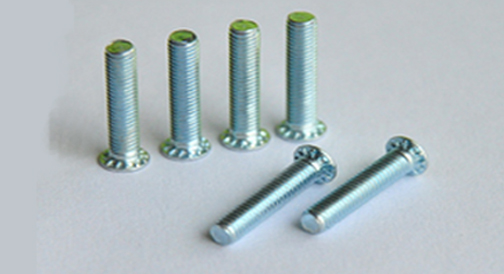Self Clinching Studs are a kind of fasteners with compact structure and easy installation, which are suitable for many occasions, such as mechanical equipment, aerospace, electronic appliances, automobiles and other fields. According to different usage scenarios and needs, there are many different types and specifications of Pressure Riveting Studs. The following are some common Pressure Riveting Studs:

Flat head self clinching studs: flat head clinching studs are a round fastener with a flat head, mainly used for joining thin sheet materials. The advantages of the flat head pressure riveting stud are simple installation, firmness and reliability, which can make the thin plate material not deformed or damaged while being fastened.
Half Eye Standoff: A half eye standoff is similar in construction to a flat head standoff, but it has an eyelet for easy attachment of coils or other accessories. The half eye standoff stud is often used in the automotive and aerospace fields because it can meet the fastening needs of high speed movement, vibration and extreme environment.
Round head standoffs: Round head standoffs have a round head that can be pressed into the materials being joined during installation to create a fastening. Round head pressure riveting studs are mainly used to connect non-metallic materials, such as plastics, fiberglass, etc., and can provide reliable sealing and waterproofing.
Barrel-head standoff studs: Barrel-head standoff studs have a barrel-shaped head and are used to connect thick plate materials, such as large machinery such as cars, trucks, and boats. Barrel head standoff studs can withstand high tensile force, have excellent fatigue strength and corrosion resistance, and are suitable for various harsh environments.
Big head standoff stud: The head of the big head standoff stud is flat or round, which can disperse the pressure and enhance the connection strength. They are commonly used to fasten large machinery and structures such as bridges, buildings and marine installations.
The above are several common types of self clinching fasteners, each of which has its own characteristics and scope of application. Factors such as material, size, shape, and fastening needs need to be considered when selecting the appropriate standoff stud. In addition, according to different usage scenarios, the pressure riveting studs can also be surface treated as needed to increase their corrosion resistance and aesthetics. For example, surface treatment methods such as galvanizing, nickel plating, chrome plating, etc. can be used, or polymer or powder coating can be sprayed on the surface.
In short, the pressure riveting stud is a kind of fastener widely used in various mechanical equipment and structural parts. Different types of pressure riveting studs have their own characteristics and advantages, and suitable studs can be selected according to specific needs. During the installation process, it is necessary to strictly follow the instructions for use to ensure the quality and safety of the installation.